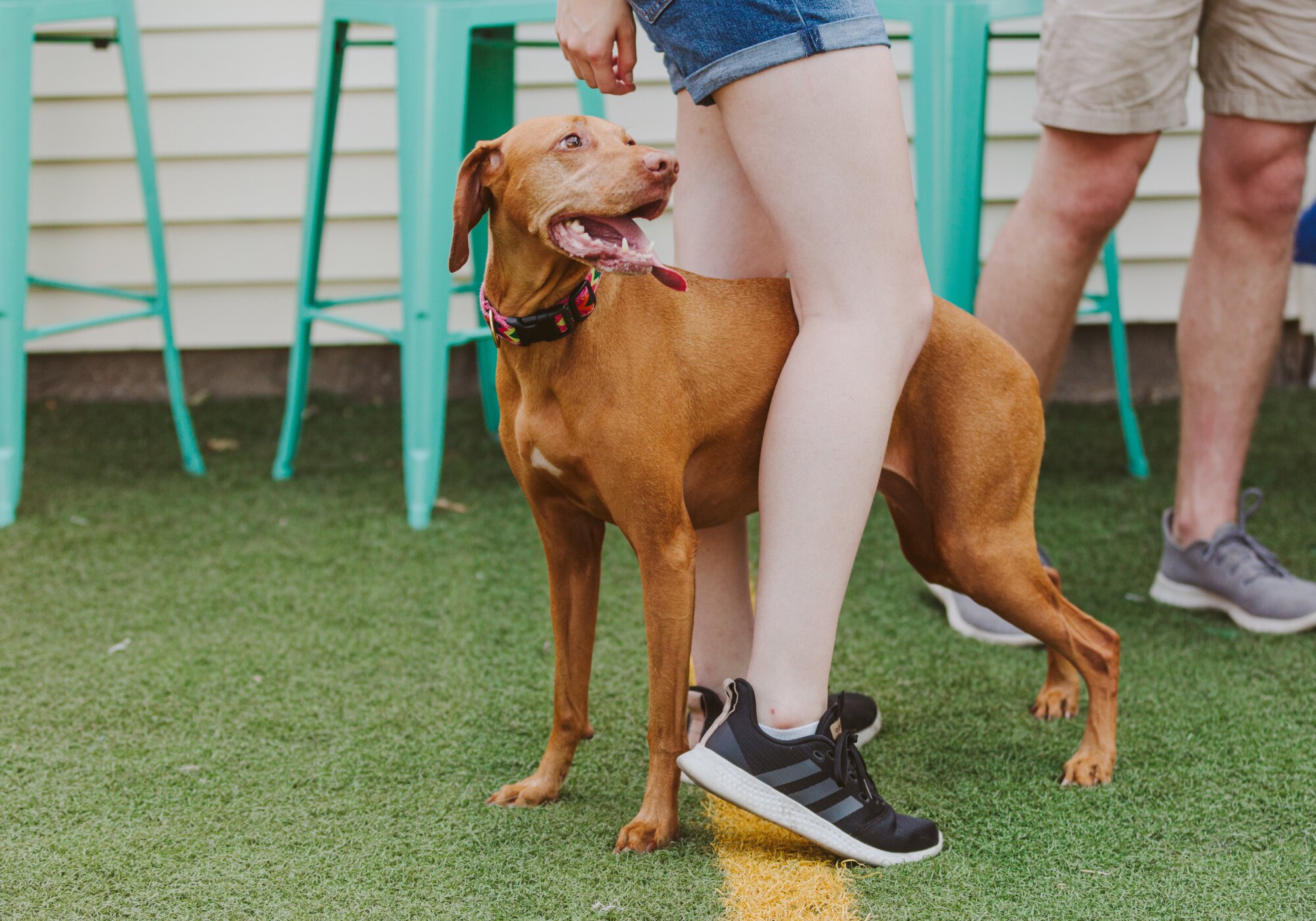We’ve all experienced itchy dogs. And we usually associate them with allergies or fleas. But, these aren’t the only pesky culprits that may be causing your pup to scratch.
While less likely to come in direct contact with, lice are another type of parasite that pet parents should know.
In this article, we’ll share:
- Why and how dogs get lice
- What are dog lice
- 7 common signs of lice
- 6 tips for preventing lice infestations

Can Dogs Get Lice?
Dogs can get lice, but it’s far more rare than other parasites. Lice love environments that are unsanitary and crowded. They are also slow-moving and need to attach each egg to a single hair shaft. This means they need close contact to spread.
Some common places dogs get lice are:
- Dog parks, kennels, events, or shows
- Contaminated bedding in multi-pet households
- Shared dog collars or grooming tools
What are Dog Lice?
Dog lice are small, wingless, six-legged insects that live in the fur of animals and humans. But, dog lice are different from human and cat lice (Felicola subrostratus).
Lice are species-specific. They rely on certain body temperatures and conditions to survive. This means that dog lice only infest dogs. So, your canine friends cannot get lice from humans (head lice) and vice versa.
Types of Lice in Dogs
There are three species of lice that may infest your pup:
- Heterodoxus spiniger (dog-chewing louse)
- Trichodectes canis (dog-chewing louse)
- Linognathus setosus (dog-sucking louse)
The good news is that they are all easily treated and prevented. Of these species, there are two types of dog lice: biting and chewing.
Chewing Lice
Chewing lice survive on skin debris, such as dead skin and dirt. This is why lice prefer unsanitary hosts and unkept environments. The more dead skin, the more food to eat.
While chewing lice don’t seek to harm your dog, they are scavengers with irritating side effects. Chewing lice may crawl around and glue their eggs to your dogs’ hair shafts which can cause:
- Irritation and redness
- Hair loss or matting
- Discomfort
- Disease
Biting or Sucking Lice
These types feast on the blood of animals. They have sharp, pointed mouths that help them bite, suck, and feed on your dog.
Sucking lice bite into your dog’s skin which can cause irritation and open wound sites. With any open wound, there is a potential for bacterial infection or other diseases.
If you see an open wound or signs of infection, contact your veterinarian right away for help. Diseases like tapeworms can be detrimental to your dog’s health.
The Life Cycle of Dog Lice
The dog lice life cycle is pretty simple. Lice develop from egg to adult lice in a few weeks and three primary phases:
- Lice eggs (nits): Female dog lice lay a handful of eggs every day. Their sticky quality makes it easy to attach them to the hair shaft of your dog's fur for safekeeping.
- Lice nymphs: After a few weeks, the eggs will molt into nymphs. Nymphs are much smaller versions of adult lice and they cannot reproduce.
- Adult lice: At this stage, the lice are fully grown and ready to spread to your pet and in your home.

What’s the Difference Between Lice and Fleas?
If your dog is itching it can mean several things — from parasites to allergies. So, identifying your pet’s health issue can be difficult. When it comes to lice and fleas there are a few distinct differences.
Mobility
Fleas are fast-moving and can jump from host to host. Lice use their mouth to attach to a hair shaft so they are less mobile.
Size
Both are around 2-4 mm small and visible to the naked eye up close. But, fleas have round bodies, suitable for feeding on the blood of animals.
Evidence
Fleas leave visible waste called flea dirt on your pet — which looks like specks of black pepper. Lice are scavengers that clean up the dead skin on your pet but leave behind sticky round nits on your animal.
Popularity
Lice are much less common than fleas. They usually get picked up from strays, unprotected pets at boarding kennels, or unhealthy dogs.
7 Ways to Tell if Your Dog Has Lice
Lice on dogs can be tricky to identify. They are sometimes mistaken for dandruff or dead skin. But lice that infest dogs have several telltale signs.
The most common symptoms and signs of lice in dogs include:
- Living or dead lice
- Excessive scratching and restlessness
- Hair loss around the neck, shoulders, groin, and ears
- Rough, dry, or matted coat
- Redness or irritation
- Open wounds or bacterial skin infections
- Tapeworm
If you think your dog has lice, don’t stress. It takes about 3-4 weeks to completely eradicate them. However, preventing future infestations is attainable.
How to get rid of and prevent lice in dogs
Lice are more of a nuisance than major threats to your pet. But, that doesn’t mean you should avoid preventing lice in the first place. Permanent lice control isn’t a short journey, but it is a simple one.
Follow these seven steps for getting rid of lice infestations for good:
1. Remove adult lice and lice eggs.
Start by brushing your dog, paying extra attention to their neck, shoulders, groin, and ears. Use a flea comb to part their fur to look for lice. Remove each louse and any nits attached to your dog’s hair shafts.
After each removal, place lice in a sealed container and soak your comb in hot, soapy water. This will kill the lice and assist your veterinarian should your dog develop other symptoms.
In severe cases, you may need to trim your dog’s coat. Contacting a professional groomer or veterinarian can be helpful for proper grooming.
2. Treat your pet with vet-quality flea and tick treatment.
It’s not always possible to remove all evidence of a lice infestation. Plus, eggs can hatch and develop for several weeks. Use a topical treatment to kill any remaining lice and keep them from re-infesting your dog.
The best topical flea and tick treatments have specific active ingredients. These can include:
- Imidacloprid
- Pyrethrin
- Permethrin
- Selamectin
- Fipronil
Most vet-quality products are safe and effective for dogs. But, they aren't always for cats so make sure you read the safety labels. There are many different methods of treatment. No matter what kind you choose, follow the directions on the label and stick to it every month.
3. Clean your pet, their bedding, and their environment.
It’s usually best to dispose of and remove any infected belongings. But if you don’t want to get rid of your pet’s things, washing these items in hot water can also do the trick:
- Bedding and blankets
- Collars, bandanas, and leash
- Plush toys
- Grooming tools
If you bathe your pet, wait at least 48 hours after applying a vet-quality topical solution before sticking them in the tub. Certain shampoos or degreasing soaps can remove the treatment and reset your “lice-free” clock.
Then, disinfect your pet’s environment and clean your home. Vacuum any high-traffic areas including carpets, floors, and fabrics.
4. Treat other pets with topical treatments.
New eggs may hatch in the weeks following your initial removal. So, it’s important to continue treatment for at least a month. This includes protecting other dogs in your household — remember, lice are species-specific.
If you have many dogs, it is best to quarantine your infested pup to prevent spreading lice to other dogs. You’ll also want to check every pet for evidence of lice and treat them with a vet-quality product. Always give them their favorite dog treat afterward.
5. Safeguard your home for re-infestation.
Consider using a household spray that contains an insect growth regulator (IGR). You can find one in stores or online. You can also contact a pest control company to spray pet-friendly insecticides in and around your home to avoid re-infestation.
6. Focus on your pet's health.
Let’s face it — lice are annoying. But they don’t have to ruin your month. Avoiding lice infestations in dogs is simple if you:
- Ensure your pet has a healthy diet
- Visit the vet regularly
- Keep their prescriptions and vaccines up-to-date
Simply being a good owner is the key to prevention. Continue to put the health of your cats and dogs first and you'll avoid an infestation from occurring at all.


